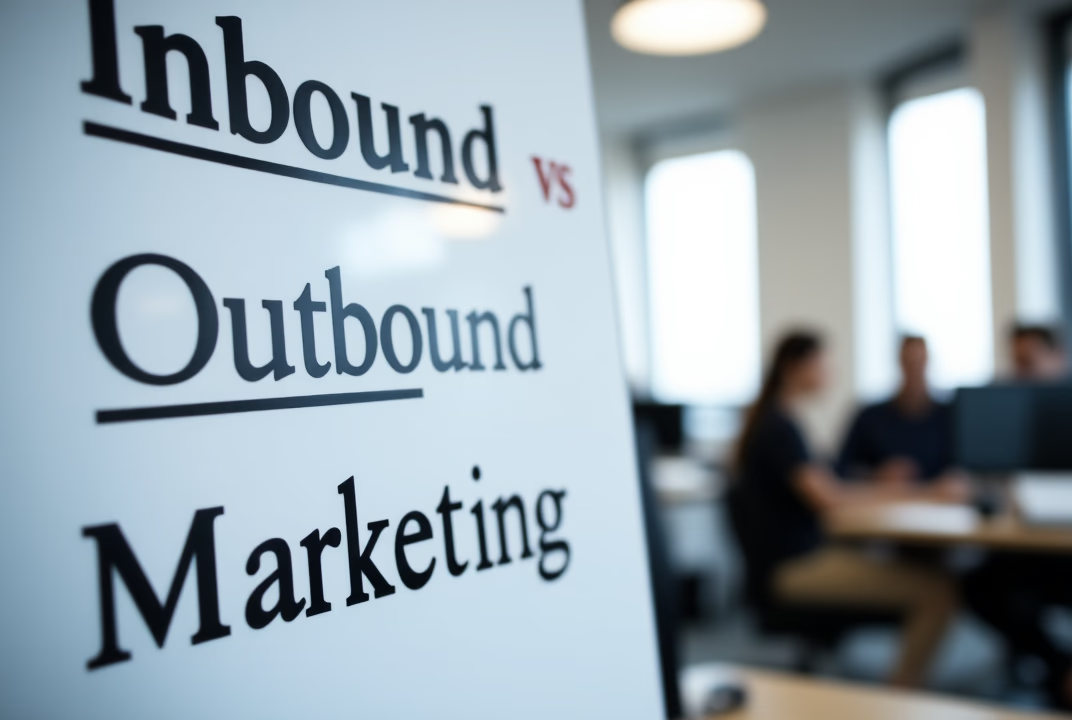
Inbound vs Outbound Marketing: What’s The Difference?
As competition intensifies and marketing budgets tighten, the debate between inbound and outbound marketing has never been more relevant for startups and small businesses. Each approach offers unique advantages and challenges, but knowing when—and how—to leverage them can be the key to unlocking consistent, high-quality leads. Dive into this comprehensive comparison to discover which strategy aligns best with your goals, resources, and long-term vision.
What Is Inbound Marketing?
Inbound marketing is a customer-centric approach that focuses on attracting potential clients by providing valuable content, resources, and experiences tailored to their needs and interests, thereby enhancing user experience. Rather than pushing messages out to a broad audience, inbound marketing draws people in through channels like blogs, search engines, social media, and email newsletters. By addressing specific pain points and offering solutions, businesses build trust and credibility, nurturing relationships that convert visitors into loyal customers over time. This strategy is especially effective for generating qualified leads and fostering long-term growth, as it aligns with how modern buyers research and make purchasing decisions.
What Is Outbound Marketing?
Outbound marketing is a proactive strategy where businesses initiate contact with potential customers through direct and often interruptive methods, such as cold calling, email blasts, display ads, and traditional media like TV, radio, or print. Unlike inbound marketing, which attracts prospects organically, outbound marketing pushes messages out to a wide audience, aiming to capture attention quickly and generate immediate responses. While this approach can deliver fast results and broad brand exposure, it often requires a larger budget and may yield lower engagement rates, as today’s consumers are increasingly selective about the messages they receive.
Inbound vs Outbound Marketing: What’s The Difference?
Approach
- Inbound Marketing: Focuses on attracting customers by creating valuable content and experiences tailored to their interests.
- Outbound Marketing: Relies on actively reaching out to potential customers through direct, often interruptive methods.
Channels
- Inbound Marketing: Utilizes blogs, SEO, social media, webinars, and email nurturing to draw in prospects.
- Outbound Marketing: Employs cold calls, direct mail, TV/radio ads, print advertising, and display ads to push messages out.
Audience Targeting
- Inbound Marketing: Targets audiences who are already searching for solutions, resulting in more qualified leads.
- Outbound Marketing: Casts a wider net, reaching out to broad or cold audiences who may not be actively seeking your product or service.
Cost and ROI
- Inbound Marketing: Typically more cost-effective over time, with a focus on building long-term relationships and sustainable growth.
- Outbound Marketing: Often requires a higher upfront investment and ongoing spend, with results that can be immediate but less sustainable.
Measurability and Adaptability
- Inbound Marketing: Easier to track, analyze, and optimize through digital analytics and marketing automation tools.
- Outbound Marketing: Can be harder to measure precisely, especially with traditional media, and less adaptable to real-time feedback.
Customer Experience
- Inbound Marketing: Builds trust and credibility by addressing customer needs and providing helpful resources.
- Outbound Marketing: Can be perceived as intrusive, sometimes leading to lower engagement and trust.
When Should You Use One Over The Other?
Choosing between inbound and outbound marketing depends on your business goals, target audience, budget, and growth stage. Inbound marketing is ideal when you want to build long-term relationships, nurture leads, and establish your brand as a trusted authority—especially if you have time to invest in content creation and organic growth. Outbound marketing, on the other hand, is effective when you need rapid results, want to reach a broader audience quickly, or are launching a new product that requires immediate visibility. Often, the most successful strategies blend both approaches, leveraging outbound tactics for quick wins while building a sustainable inbound engine for ongoing lead generation and brand loyalty.
What Is More Effective Inbound or Outbound?
The effectiveness of inbound versus outbound marketing ultimately depends on your specific business objectives, industry, and target audience. Inbound marketing tends to deliver higher-quality leads, better ROI, and long-term growth by building trust and engaging prospects who are already interested in your solutions. Outbound marketing, while often more expensive and less targeted, can generate immediate results and boost brand awareness, especially for new products or markets. For most businesses, a balanced approach that combines the strengths of both strategies—using outbound for quick traction and inbound for sustainable growth—yields the most effective and scalable results.
Can You Combine Inbound and Outbound Marketing?
Absolutely, combining inbound and outbound marketing can create a powerful, well-rounded strategy that maximizes both immediate impact and long-term growth. By integrating outbound tactics—such as targeted ads or outreach campaigns—with inbound efforts like content marketing and SEO, you can quickly generate awareness while nurturing leads through valuable, trust-building experiences. This hybrid approach allows you to reach new audiences, accelerate your sales cycle, and reinforce your brand’s credibility, ensuring that you capture both active seekers and those who may not yet realize they need your solution. Ultimately, a blended strategy offers greater flexibility and resilience in an ever-changing marketing landscape.
Inbound vs Outbound Marketing
Aspect | Inbound Marketing | Outbound Marketing |
Approach | Attracts customers by providing valuable content and resources tailored to their needs | Proactively reaches out to potential customers through direct, often interruptive methods |
Channels | Blogs, SEO, social media, webinars, email nurturing | Cold calls, direct mail, TV/radio ads, print, display ads |
Audience Targeting | Focuses on audiences actively seeking solutions, resulting in more qualified leads | Casts a wide net to reach broad or cold audiences |
Cost & ROI | More cost-effective over time; builds sustainable growth | Higher upfront and ongoing costs; delivers quick but less sustainable results |
Measurability | Easy to track and optimize with digital analytics | Harder to measure, especially with traditional media |
Customer Experience | Builds trust and credibility through helpful resources | Can be perceived as intrusive, sometimes lowering engagement |
Best Use Case | Long-term relationship building, brand authority, nurturing leads | Rapid results, immediate visibility, new product launches |
Is Outbound Better For Short-Term Lead Generation?
Yes, outbound marketing is often more effective for short-term lead generation because it allows businesses to proactively reach out to potential customers and generate immediate responses. Tactics like cold calling, targeted email campaigns, and paid advertising can quickly put your message in front of a large audience, driving rapid awareness and engagement. While these methods may require a higher upfront investment and can sometimes yield lower-quality leads compared to inbound strategies, they are ideal when you need to fill your pipeline quickly or launch a new product that demands fast traction. For businesses seeking quick wins, outbound marketing provides the speed and directness that inbound alone may not deliver.
Common Inbound and Outbound Marketing Mistakes To Avoid
- Neglecting Audience Research: Failing to deeply understand your target audience’s needs, behaviors, and pain points can lead to irrelevant messaging and wasted marketing spend in both inbound and outbound campaigns.
- Inconsistent Messaging: Delivering mixed or unclear messages across channels confuses prospects and weakens your brand’s credibility, making it harder to build trust and drive conversions.
- Overlooking Measurement and Optimization: Not tracking key metrics or regularly analyzing campaign performance prevents you from identifying what’s working, leading to missed opportunities for improvement and wasted resources.
- Relying Too Heavily on One Approach: Focusing exclusively on either inbound or outbound marketing can limit your reach and effectiveness; a balanced strategy often yields better results.
- Ignoring Follow-Up and Lead Nurturing: Failing to engage and nurture leads after initial contact—whether through content or outreach—can result in lost opportunities and lower overall ROI.
Conclusion
Inbound and outbound marketing each offer distinct advantages, and the most successful businesses know how to leverage both to achieve their growth goals. Inbound marketing excels at building trust, nurturing relationships, and delivering sustainable, long-term results, while outbound marketing provides the speed and reach needed for immediate impact and rapid lead generation. By understanding the strengths and limitations of each approach, you can craft a marketing strategy that aligns with your objectives, maximizes your budget, and positions your business for scalable success in a competitive landscape.
Final Thoughts
Are you struggling to decide between inbound and outbound marketing to drive your next phase of growth? Partner with GTMify, your trusted advisor for effective go-to-market strategies at any stage of your business. Backed by over 50 years of experience and a history of sending 100,000 emails every month, we’re committed to helping you achieve and surpass your objectives. Contact GTMify today to discover how our expertise can guide your going to market journey with clarity and confidence.
Sources

